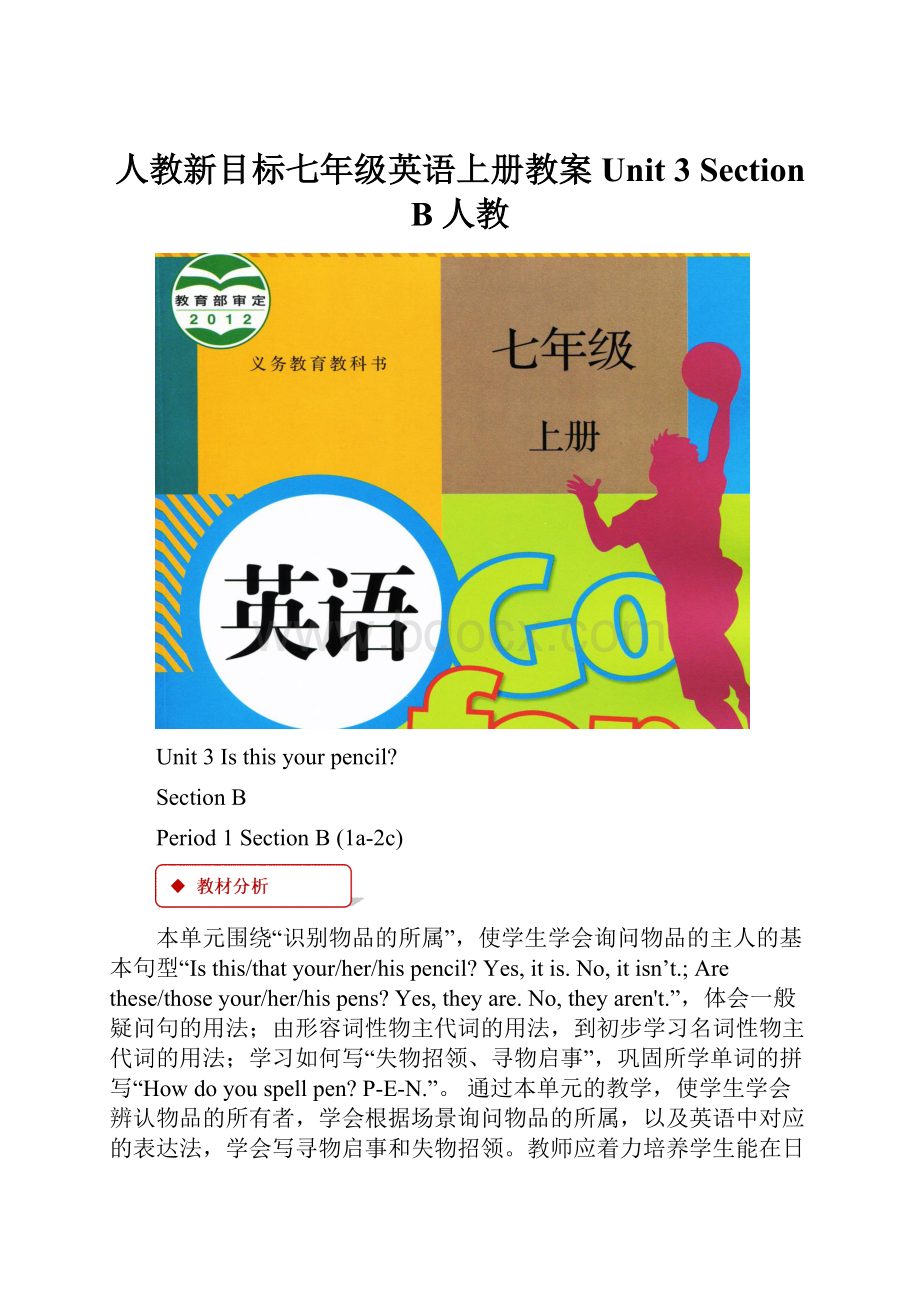人教新目标七年级英语上册教案Unit 3 Section B 人教.docx
《人教新目标七年级英语上册教案Unit 3 Section B 人教.docx》由会员分享,可在线阅读,更多相关《人教新目标七年级英语上册教案Unit 3 Section B 人教.docx(13页珍藏版)》请在冰豆网上搜索。

人教新目标七年级英语上册教案Unit3SectionB人教
Unit3Isthisyourpencil?
SectionB
Period1SectionB(1a-2c)
本单元围绕“识别物品的所属”,使学生学会询问物品的主人的基本句型“Isthis/thatyour/her/hispencil?
Yes,itis.No,itisn’t.;Arethese/thoseyour/her/hispens?
Yes,theyare.No,theyaren't.”,体会一般疑问句的用法;由形容词性物主代词的用法,到初步学习名词性物主代词的用法;学习如何写“失物招领、寻物启事”,巩固所学单词的拼写“Howdoyouspellpen?
P-E-N.”。
通过本单元的教学,使学生学会辨认物品的所有者,学会根据场景询问物品的所属,以及英语中对应的表达法,学会写寻物启事和失物招领。
教师应着力培养学生能在日常交际交往中有效地使用语言进行表达,与他人沟通信息,为今后学习打下坚实的语言基础。
本单元与第二单元衔接紧密,由this,that的学习过渡到these,those的学习,由指示一个人、物过渡到指示多个人、物,使学生学会区分远近单复数。
【知识与能力目标】
1)掌握下列词汇:
baseball,watch,computergame,IDcard,notebook,ring,bag,library,lost,at,call
理解下列词汇:
ask,some,found,classroom,e-mail
2)掌握下列句型:
—What’sthis?
—It’sawatch.
—Howdoyouspellit?
—W-A-T-C-H.
3)能够使用目标语言询问东西的所属,或者寻找物品的主人。
4)能够读懂一些简单的招领和寻物启示。
【过程与方法目标】
采用contestguessing和Roleplaying的学习策略,利用实物演示、教学图片或制作多媒体课件来展开课堂Pairwork,Groupwork的口语交际活动,识别物品的所属,体会指示代词、一般疑问句的用法。
【情感态度价值观目标】
通过学习“询问物品所属”及阅读“寻物启事和失物招领”。
既可以提高学生遇到类似挫折时的解决问题的能力,激发学生的主动性和学习兴趣。
又能培养学生拾金不昧的精神和助人为乐、团结友爱的品德。
【教学重点】
1)学习新词汇及询问如何拼写词汇的句型。
2)通过听、说的训练来让学生熟练掌握询问物品的所属或寻找物品的主人。
3)阅读一些简单的招领和寻物启示,并能获得相关信息。
【教学难点】
阅读一些简单的招领和寻物启示,并能获得相关信息。
1.准备录音机和磁带;
2.设计课后巩固练习;
3.ppt;
3.
Step1.Warm-upandrevision
1.Greetingthestudentsandcheckthehomework.
2.ReviewtheschoolthingswelearnedinSectionA.LetSssaytheschoolthingstheyhave.
3.Pickupsomeschoolthingsfromthestudents’deskandaskaboutthem.(Usingthis,that,these,those)Letotherstudentsanswerthequestions.
T:
IsthisYuKe’sruler?
Ss:
Yes,itis.It’shers.
T:
IsthatYuKe’spencil?
Ss:
No,itisn’t.It’sWanYang’s.
T:
AretheseYuKe’spens?
Ss:
Yes,theyare.They’rehers.
T:
ArethoseXuMengyuan’sbooks?
Ss:
No,theyaren’t.They’reLiYuanyuan’s.
…
Step2.Presentation
1.T:
Lookatthepicture.
(Showstudentsapictureofawatch.)
T:
What’sthisinEnglish?
It’sawatch.
(Askastudent)What’sthisinEnglish?
S1:
It’sawatch.
T:
Good.(Askanotherstudent.)What’sthisinEnglish?
S2:
It’sawatch.
T:
Howdowespellwatch?
(Showstudentsthespelling.)
W-A-T-C-H,watch.Readafterme,please.
S3:
W-A-T-C-H,watch.
2.(Teachtheotherwords“baseball,computergame,key,notebook,ringandIDcard…”inthesameway.)
T:
Let’ssaythewordsagain.What’sthisinEnglish?
(Showthewordsrandom.Askquestionslikethis.)
S4:
It’sakey.
T:
Howdoyouspellit?
S4:
K-E-Y.
Step3.Practice
1. T:
Nowlookatthe1a.Herearesomenewwordsintheboxandsomepicturesbelowthebox.Matchthewordswiththethingsinthepicture.
Ss:
OK.(Ssworkwiththeirpartnerstrytomatchthewordswiththethingsinthepicture.)
2.Checktheanswers.
3.T:
Nowpleaseworkwithyourpartner,practicetheconversationin1b.Usethepicturesin1a.
(Studentspracticetheconversation.Asstudentswork,theteachermovesaroundandhelpthem.)
4.Asksomepairstoactouttheconversation.
Step4.Listening
1.Workon1c.
T:
Listentotheconversation.Payspecialattentiontothenamesofobjects.Youwillhearsomeofthenames,notallofthem.Circleonthepictureeachitemwhosenameismentionedintheconversations.
(Playtherecordingtwice.Studentslistenandcircletheitems.)
T:
Let’schecktheanswers,OK?
S1:
…
T:
Whowouldliketosaythecircledwordsagain?
S2:
…
(Checktheanswerswiththeclass)
2.Workon1d.
T:
Pleaselookatthetwopicturesin2b.OneisLinda,andtheotherisMike.Listentotheconversationsagain.ThistimeyouwillpayattentiontothethingsLindaandMikearelookingfor.Thenwritedownthenamesofthethingsundereachperson’spicture.
(Playtherecordingforthestudentstowritedownthewords.)
T:
Well,whatisLindalookingfor?
S3:
…
T:
WhataboutMike?
Whatishelookingfor?
S4:
…
(Checktheanswerswiththeclass)
Step5.Pairwork(1d)
1.Nowlet’smakeconversationsaboutthethingsin1d.SupposeyouareLindaandyourpartnerisMike.Makeaconversationandpracticeit.Thenyoucanchangeroles.YourpartnerisLindaandyouareMike.Makeanotherconversationagainandpracticeit.
2.Ssmakeconversationsastheteacherasks.
3.Letsomepairsactouttheirconversations.
Step6.Writing(2a)
1.Weallhavemanyschoolthings.Wealwayslosesomeschoolthingseasily.Nowdiscusstheschoolthingsyouloseeasilywithyourpartner.Writethemdownonyourworkbook.Thenreportthemtotheclass.
2.Ssworkwiththeirpartners.
3.LetsomeSsreporttheirthingstotheclass.
Step7.Reading(2b,2c)
1.T:
Haveyoueverpickedupothers’thingsorlostanything?
Whatarethey?
S1:
Ilostabackpack.
S2:
Ipickedupapen.
T:
Good.Whatwillyoudowiththesethings?
Howdidyoureturnorfindthem?
Haveadiscussionwithyourpartner.
T:
Ifyoulostsomething,whatshouldyoudo?
YoucanansweritinEnglishorChinese.
S1:
Call“110”.
S2:
Telltheteacheraboutit.
S3:
Askmyclassmatetohelpmelookforit.
S4:
Tellmyparents.
S5:
寻物启事。
T:
Youaregreat!
Herearefournoticesontheboard.Readthenoticesandcirclethelostthings.
2.LetsomeSssaytheanswers.
3.Readthenoticesagainandwritedowntheitems.Thencheck(√)LostorFound.
4.阅读指导
①在第一条信息中,开头是LinHai,结尾是Mike,由常识可知是Mike给LinHai的留言条,关键句“Isityours?
它是你的吗?
”,可知是Mike拾到的该物。
故此条是Found条。
②由第二条信息中的第一句话“Isthisyourwatch?
”,可知是John捡到的手表。
故此条也是Found条。
③第三条和第四信息中明确有Found和Lost的说明,故较容易确定。
5.Checktheanswerswiththeclass.
6.Explainsomelanguagepoints.
watch&clock
Howdoyouspellit?
ask...for...
in
callsb.at...
e-mailsb.at...
7.Domoreexercisestoconsolidatewhattheyhavelearned.
Step8.Homework
1.Rememberthenewwordswelearnedtoday.
2.认真阅读下面“失物启事”与“招领启事”并完成后面的句子。
LostMyschoolIDcard.MynameisMike.Pleasecall263-1412.
FoundNewwatch.Isthisyourwatch?
PleasecallAnn.Phone553-7618.
①________losttheschoolIDcard?
②Youcancall________togetthenewwatchback?
③Mike’stelephonenumberis_________?
④________foundthenewwatch?
BlackboardDesign:
Unit3Isthisyourpencil?
SectionB(1a-2c)
—What’sthis?
—It’sawatch.
—Howdoyouspellit?
—W-A-T-C-H.
callmeat…e-mailmeat…
略
Period2SectionB3a-SelfCheck
【知识与能力目标】
1)总结复习所学过的有关学习用品的英语词汇。
2)总结复习形容词性物主代词与名词性物主代词,并了解它们的用法。
3)能够使用目标语言询问东西的所属,或者寻找物品的主人。
4)在老师的指点帮助下能够写一些简单的招领和寻物启示。
【过程与方法目标】
采用contestguessing和Roleplaying的学习策略,利用实物演示、教学图片或制作多媒体课件来展开课堂Pairwork,Groupwork的口语交际活动,识别物品的所属,体会指示代词、一般疑问句的用法。
【情感态度价值观目标】
通过学习“询问物品所属”及写作“寻物启事和失物招领”。
既可以提高学生遇到类似挫折时的解决问题的能力,激发学生的主动性和学习兴趣。
又能培养学生拾金不昧的精神和助人为乐、团结友爱的品德。
【教学重点】
1)总结复习有关学习用品的词汇。
2)通过读、写的训练来让学生熟练掌握询问物品的所属或寻找物品的主人。
3)写作一些简单的招领和寻物启示。
【教学难点】
指导学生写作一些简单的招领和寻物启示。
1.准备录音机和磁带;
2.设计课后巩固练习;
3.ppt;
Step1.Warm-upandrevision
1.GreetingtheSs.Checkthehomework.
2.ShowsomepicturesandreviewtheschoolthingstheylearnedinSectionB.
T:
What’sthis?
Ss:
It’s....
T:
Howdoyouspellit?
Ss:
....
T:
Isthisyour...?
Ss:
....
T:
Whatarethose?
Ss:
Theyare....
T:
Aretheseyour...?
Ss:
....
Step2.Presentation
(ShowasetofkeystotheSs.)
T:
Thesearesomekeys.Thisisasetofkeys.
(Writeontheblackboard.)
asetof一套;一幅;一组asetofstamps一套邮票
abagof一袋子……abagofrice一袋大米
abagofapples一袋苹果
Step3.Writing
1.Let’sworkon3a.Herearetwonoticesbutsomewordsinthenotesaremissing.Readthenoticesandcompletethenoticeswiththewordsorphonenumberinthebox.
2.AsksomeSsreadthewordsinthebox.OnereadtheminEnglish.TheotherreadtheminChinese.
3.Ssreadandcompletethenotices.Thenchecktheanswers.
4.Workon3b.
写作指导:
T:
Haveyoueverpickedupothers’thingsorlostanything?
Whatarethey?
S1:
Ilostadictionary.
S2:
Ipickedupawatch.
T:
Good.Whatwillyoudowiththesethings?
Ss:
…Writeanoticeandputupinthelostandfound.
T:
Allofyouareright.Todaywearegoingtolearnhowtowrite“Lost”and“Found”notices.Lookatthe“Lost”and“Found”noticesin3aandfindouttheimportantinformationaboutit.
S1:
Thelostthingandfoundthing.
S2:
Thenameoftheowner.
S3:
Color.
S4:
Telephonenumber.
S5:
Picture.
T:
Yes.Youhavedoneverywell.Ifwewrite“Lost”or“Found”,wemustwritethelostthing,thefoundthing,theperson’sname,telephonenumberandcolor,wecanalsoputapictureofthethingonit.
2.T:
OK.Nowlet’strytowriteit.Youmayusetheonein2bortheonein3aasamodel.
(Studentswritetheirbulletinboardnoticesandtheteachermovesaroundtheroomofferinglanguagesupportasneeded.)
T:
Let’sreadsomeofyournotices.
(Asksomestudentsreadtheirmessagealoud.Andotherstohelpcorrecttheirwork.)
Step4.SelfCheck1
1.T:
We’velearnedmanyschoolthings.Nowfirstreviewalltheschoolthingsinthreeminutes.Thenlet’shaveacompetition.We’llwritetheschoolthingsyoucanrememberinapieceofpaper.Let’sseewhocanrememberthemost.
2.Ssreviewthewordsoftheschoolthingsquickly.Thenhaveacompetition.
3.Checkthenumbersofthewordsontheirpapertoseewhodoesthebest.
Step5.SelfCheck2
1.物主代词即代指事物的主人(我的,你的,他的),分为形容词性物主代词(名词前)和名词性物主代词(后无名词)。
形容词性物主代词
形容词性物主代词:
形容词性物主代词相当于形容词,其后必须跟名词。
形容词性物主代词不能单独使用,后面必接名词,表示所有。
mypen我的钢笔
yourschoolbag你的书包
hisbike他的自行车
Isthatyourbike?
那是你的自行车吗?
Thoseareourbooks.那些是我们的书。
名词性物主代词
名词性物主代词相当于一个名词,不能用于名词前,能单独使用。
形容词性物主代词与名词性物主代词之间的关系为:
名词性物主代词=相应的形容词性物主代词+名词
Yourbedroom(=yours)isbig.Mine(=Mybedroom)isbig,too.你的卧室大。
我的卧室也大。
Thecarishers.这辆汽车是她的。
Theirkitesaregreenandmineisred.他们的风筝是绿色的,我的是红色的。
2.人称代词的主格作主语,宾格作动词的宾语和介词的宾语。
如:
I’mfine.我很好。
Youaremyfriend.你是我的